
This is the tale of a man who was born and bred and died at Portsmouth. In the nineteenth century, he had a chequered career lasting thirty years in the Royal Navy (which resulted in him changing his surname) – and for the next thirty years he was familiar face at Portsmouth Point. His death, in 1879, was reported by more than twenty British newspapers.
The parish registers provide birth and baptismal dates for James Pafford, the second son of George and Mary Pafford. He was born at Portsmouth on 6 April 1793 and christened at Holy Trinity, Gosport on 23 June 1793. Little is known about George Pafford other than that during the first six months of 1800 he served briefly as an Ordinary Seaman on Goliath, a hulk 'in ordinary' at Portsmouth Harbour.
James joined the Royal Navy as a volunteer 'Boy' third rate on 14 July 1805, when he was 12¼ years old.
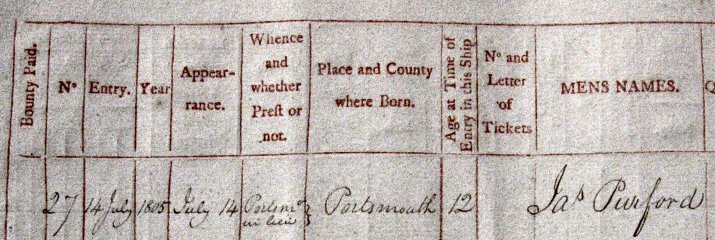
When James enlisted, he was noted as 'Jas Purford'. This is possibly an reflection of how he pronounced his surname. He was assigned to Defence - a 74-gun, third-rate ship of the line. She had a crew of around 700 people and was one of the most famous ships of the period, fighting at the battles of Cape St Vincent, the 'Glorious First of June' in 1794 and the Nile in 1798.
So, on a Sunday in the summer of 1805 (a 'moderate and cloudy' day) young Jim was rowed out to join his ship which was moored at Spithead, between Portsmouth and the Isle of Wight. Almost immediately, Defence sailed for Cawsand Bay, off Plymouth. One can only wonder at James' emotions as his home receded from view until it was hidden by the loom of the Isle of Wight.
About ships' boys
Ship's boys were generally put to all the dirty and trivial work of the ship such as cleaning out the pigsties, the hen-coops and the 'head' or toilets. They were often bullied by sailors who loved 'to find the opportunity to act the superior over someone'. When ships weighed anchor, they assisted by 'holding on and carrying forward nippers' which led to them being called, 'nippers'. Some were servants of midshipmen, boatswains or warrant and wardroom officers.
A boy could drink half of a man's allowance of rum (ie half a gill) and wine (ie a quarter of a pint) and pay in lieu of the half he didn't draw. On these tots, it was possible to get drunk and be flogged with the boatswain's cane. Boys were generally berthed apart from the other sailors (for good reason) and slung their hammocks in the sheet-anchor cable tiers or on one of the upper gun decks.
In action, boys were 'powder monkeys' - stationed at a gun with orders to supply it with cartridges from the magazine. The cartridges were carried using a lidded, wooden case into which a cylindrical flannel bag fitted. Being short, boys were protected behind the ship's gunwale, out of sight of enemy sharp-shooters. If they tried to run away from the magazine into the shelter of the orlop deck, the midshipman stationed at the hatchway might shoot them or beat them back with a pistol butt.
We left James at Cawsand Bay. He had an early introduction to the rigours of naval life. On 19 July, a sailor died and on 3 August three seamen were given twelve lashes each for disobeying orders and neglect of duty. On 27 July 1805, Defence joined the fleet blockading Cadiz, Spain.
The Battle of Trafalgar
Early in the morning of 19 October 1805, the signal was hoisted, and repeated by several ships including Defence, 'The enemy is coming out'.
The English fleet consisted of thirty-three ships, crewed by more than 15,000 sailors. James was one of the youngest cogs in this huge war machine. Imagine his feelings when he saw the forest of masts of the forty-one enemy ships that dominated the horizon! The crews cheered and 'rushed up the hatchways to get a glimpse of the hostile fleet. The delight manifested exceeded anything I ever witnessed'.
Defence was stationed at the end of one of two parallel lines of ships that cut through the French line. This meant its crew spent a long time waiting and thinking of the furore to come, while watching the great battle unfold. At one stage, Defence was given a 'hurry-up' call, 'Make all sail possible with safety to the masts'. Forty-six minutes later came Nelson's rallying call, 'England expects that every man will do his duty'.
This signal was 'received throughout the fleet with a shout of answering acclamation, made sublime by the spirit which it breathed and the feeling which it expressed'. When it was communicated through the decks, 'it was received with enthusiastic cheers and each bosom glowed with ardour at this appeal to individual valour'.
Eventually, Defence was able to engage the enemy. She was evenly matched with the 74-gun Berwick which she dismasted, leaving her to be captured by Achilles. Defence then fought the Spanish ship, San Idefonso, which she captured. During the battle, Defence lost seven men killed, while twenty-nine were wounded.
In the din of battle, James would have run to and fro over the bloody and splinter-scattered deck carrying the cartridge cases from the magazine to his allotted cannon while braving enemy broadsides and the snipers in the opposing ship's rigging.
Eventually, the conflict ceased to rage, but the ships were faced with a new threat - a storm. The signal to 'Anchor' was hoisted. Many captains responded that they couldn't comply as they had lost their anchors or their cables had been severed. Defence was one of the few that were able to ride out the gale at anchor with her prize, San Idefonso.
Defence put in to Gibraltar Bay on 3 November and returned home to Spithead on 2 December 1805, anchoring there for four days - a wonderful homecoming for James and his family who now knew that he had survived possibly the most famous sea battle ever fought. After four days respite, they received the signal, 'Prepare for sea'. On 6 December, Defence set sail again, bound for Chatham.
James was then paid a total of £1 15s 6d for more than five months work. On 24 December 1805, the Captain's Log notes, 'Sent draft of men on board the (HMS) Thames'. Included among this party was James. He had a new home for Christmas and he was destined for colder climes.
James Pafford and HMS Thames
Thames was a new 32-gun fifth rate that had been built at Chatham. Compared with Defence, she may well have been claustrophobic for James. She, together with Phoebe and Blanche, were dispatched to the Arctic to deal with a French squadron which was reported to be harassing British and Russian fishing and merchant vessels. On 10 July 1806, they were at Spitzbergen, 600 miles north of the northernmost tip of Norway, but thankfully by late September Thames was patrolling the warmer straits of Dover.
After this tour of duty, on 13 February 1807, Thames anchored at Spithead. James now made a decision about his future life as a sailor. In the Muster Book beside his name is an 'R'. This stands for 'Ran'. James deserted from the Royal Navy at Portsmouth on 28 February 1807, forsaking pay that was due. Life on the ocean wave was no longer for this fourteen-year-old.

Six months later, James rejoined the Royal Navy on around 28 August 1807 as a standing ordinary seaman. He was now recorded as James Pafford and was attached to Robust (third rate, 74-guns) which was moored 'in ordinary' at Portsmouth Harbour. He was part of a twelve-man skeleton crew which was maintaining the fifty-year-old hulk. He was paid £1 8s 6d for the first month and two days work, which is about 5/3d a week (26p). James (now an able-bodied seaman) was then transferred to Blake (third rate, 74-guns) in the harbour on 21 July 1814 as part of a ten-man crew. He received £5 10/- for thirteen weeks work - about 8 shillings a week - which was on a par with agricultural workers earnings. Then, James was assigned to yet another hulk - Edinburgh (74 guns) on 1 January 1815.
It was while he was on Edinburgh that he and two other able-bodied seamen, John Buttin (sic) and John Akins, were dismissed from the Navy on 11 December 1815 for 'neglect of duty'.
What they did, or didn't do to deserve this penalty is not known. However, if their duties are considered, a clue may emerge. The small crew checked the level of water in the ship's well; inspected the mooring ropes; ensured that the magazine was clean and dry and prevented unauthorised entry on board ship as watch keepers and stayed awake at night, answering the shouts of the duty officer as he rowed his rounds. A family legend may suggest that drunkenness was the root cause of James' dismissal.
What was James to do? He was twenty-two and knew only a life in the navy. As he married a year later, there may have been additional pressure on him to secure employment. His response to his predicament was simply to enlist in the service again, using a different name - arise, James Mills. He probably chose Mills because it was a surname in his family tree - his sister was christened Charlotte Mills Pafford.
To sign on again under these circumstances was not unusual. John Crump of Portsmouth Dockyard Museum writes, '...I am in no doubt that a man could have re-enlisted under another assumed name; this probably happened frequently'. Naval historian, Paul Benyon adds, 'it wouldn't surprise me...as long as the offence wasn't too serious. The Navy appears to have been surprisingly forgiving'.
So, James joined Prince on 22 June 1816 retaining his rating as an able-bodied seaman.
When he married later in the year, on Christmas Day, Prince was given as his abode but James told the St Mary, Portsea clergyman that his name was Pafford. He was earning £5 8s 10d for thirteen week's work.
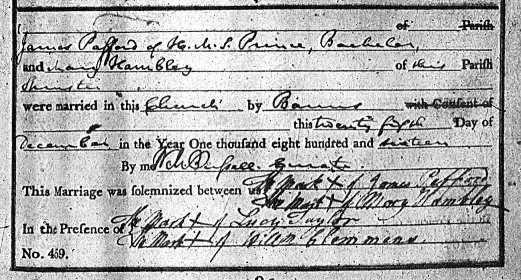
James was still attached to Prince when their first child, George Thomas Pafford, was born and baptised in 1818 (For naval records, James might now be registered as James Mills, but when his first children were christened - and buried - he clung to his surname Pafford.)
Where did James and Mary live? According to the parish record of the baptism of George Thomas Pafford, at the end of May 1818, the family were at Dock Row, Portsea, which, as the name implies, was near the Dockyard. By the summer of 1819, according to the Pay Books of Sapphire, James and Mary had moved to the enclave known as Portsea Dockyard 'New Buildings', (specifically to Sharps Buildings) where their second child, James was born. In 1820 and 1824, the family were still anchored at New Buildings but when a further son, Thomas Pafford, was baptised, they had relocated to Strong's Buildings, which were situated on the shore line of Portsmouth Harbour.
After leaving Prince, by 1822 James was on board the 36-gun Lacedemonian (launched, 1812: disposed of, 1822) as one of its seven-man crew. His pay had decreased slightly to £5 2s 11d a quarter. When this ship was taken out of commission, James was transferred to what was to be his last ship, the 74-gun, third rate Pembroke. He served on her until 27 March 1836 when she was 'in dock' with a four-man crew. He remained an able-bodied seaman. Thereafter, the crews of ships in Portsmouth Ordinary are listed according to the vessels on which they served ie they are not catalogued in 'Portsmouth Ordinary' ledgers. James was not listed after 1836. As shown by the census of 1841, he was no longer a mariner, but a labourer.
James and Mary Pafford/Mills and the 1841 census
The 1841 census notes the family as living at East Street, Portsmouth Point. But this information is a little clouded as the family were recorded as Miles. However, there were sufficient signs (for example the proximity of Mary's sister and husband, John and Susanna [nee Hambley] Lemmon) that this was an enumerator's error. Confirmation that these were indeed the Mills was provided by the death of Mary Ann Pafford Mills (sic), aged six, two days after the census was taken. Her residence was noted on her death certificate as East Street - she was shown as Mary Miles (6) in the census. Mary Ann died of inflamation of the bowel. This was probably caused by either ulcerative colitis or Chrohn's disease. The symptoms include abdominal pain and diarrhoea. The informant of the death was Susanna Lemmon, Mary Mills' sister.
As recorded in the census of 1841, James was a labourer - probably a dock labourer. Perhaps their move from New Buildings was prompted by Mary's desire to be near her sister, Susanna, and the opportunities for work around the Camber harbour.
James Mills - Camber Bridge Keeper
In 1851, James and family were still living at East Street. The census details suggest that John and Susanna Lemmon were living next door, or maybe even in the same building, James was now a Camber Bridge Keeper. With a flourish the enumerator added that he was also a pensioner and that his was a civic appointment.
The Bridge connected the sea-end of East Street and the Town Quay. Although more than eighty feet in length, the bridge spanned a gap of fifty-four feet and was in two halves which swung up and down to allow vessels access to and from the Inner Camber. It was surfaced with three-inch planking and carried a carriageway that was 9½ feet wide and footways, 3 feet 4 inches wide.
The Bridge was opened on 14 June 1843 as part of the improvements to the Camber. Its purpose was to provide a short cut between the two areas of Portsea, Landport and Portsmouth Point with its ferries to Gosport and the Isle of Wight. Now, workers in the Dockyard who lived at Point did not have to follow the shore line to get to work. In 1860, it was noted that 'the bridge was in a great thoroughfare and had immense traffic over it'. As well as horses and carts, oxen and other livestock were driven over the bridge.
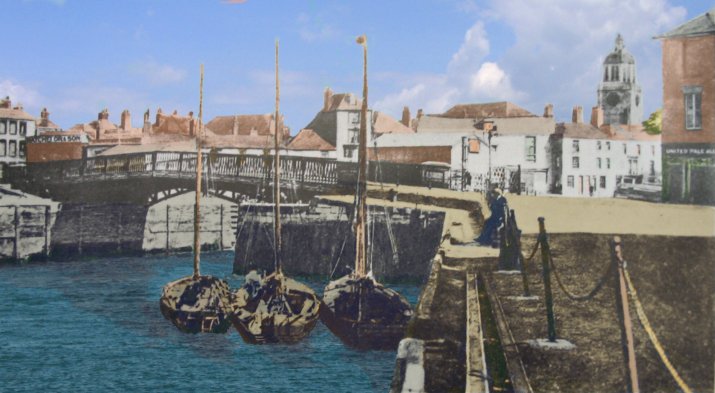
The duties of the Bridge Keeper were to open the bridge and monitor the traffic that crossed over it. But, the bridge was also a focal point for trouble and disturbance. In October 1848, the Hampshire Telegraph directed 'the attention of the police to the nuisance committed by the boys and crews of the potato vessels in the Camber who are in the constant habit of throwing potatoes at the passengers on the bridge...'. In January 1851, four boys were charged with pelting an agent's clerk with 'sprate and scud' from the bridge as he passed underneath in a boat.
Then, in September 1854, two men were charged with assaulting John Wood who was also employed at the Camber Bridge. He was opening it when the defendants, who were labourers on colliers, knocked off his hat six times, hustled him and jumped down on him. All the while there was a crowd throwing stones and 'otherwise annoying' Wood. The Chamberlain added that these disturbances were continually being created on the Town Quay.
The Mills' home at Portsmouth Point 1861 - 1879
In 1861, James and Mary were living at 2 Beals Yard, Point, which was just off East Street. Almost predictably, at No.1 next door, were John and Susanna Lemmon. The families were apparently inseparable.
Ten years later, in 1871, James (now 78 years old) and Mary were still in the same immediate area at Point alongside the Inner Camber Quay. James was a (naval) pensioner. When Mary died on 11 December 1873, her address was given as 42 East Street, Point. (James and Mary may well have not moved after 1871 as many of the houses along East Street actually backed onto the Inner Camber [see below]).
Documents at Hampshire Archives which detail improvements to the Inner Camber help to pinpoint the exact position of their home. The records include a map and key to occupants of dwellings around the south side of East Street. The location of the Mills home, as depicted below, may well explain why the Mills household was described as being at the Inner Camber Quay in the census of 1871. Their home is the house which is set back to the right of the Orange Tree Tavern.
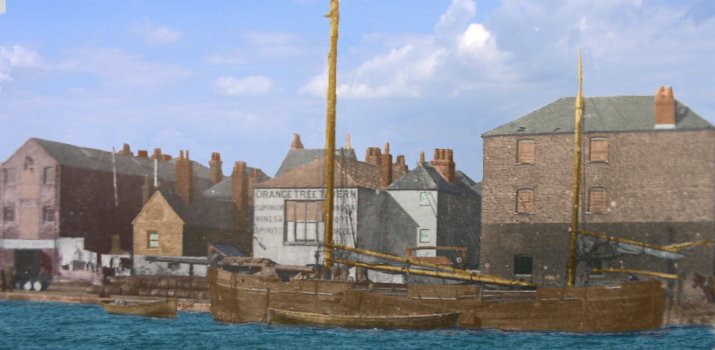
When Mary passed away, the family went to great trouble to highlight the change in their surname by submitting two identical announcements in the Hampshire Telegraph of her passing - as Mary Mills and Mary Pafford (see below). She was 77 years old and died of 'senectus' or plain old age. She and James were living at 23, East Street and James was described as a 'wharf labourer'. The informant of her death was Harriet Mills, Mary's daughter-in-law, of 21 East Street who was present at the death.
According to news reports, James worked at the Camber Bridge until his death – although from the summer of 1878, he was able to do only a little work for which he received half pay of eight shillings a week. James (officially a naval pensioner - ticket No. 826) died on 24 January 1879 from exhaustion brought on by the 'chronic enlargement of the prostate gland'. (A nurse recently observed that he must have been in agony!) He was living at 46, East Street and his age was given as 89 years old. Interestingly, the newspaper death notice described him as James Pafford and the death certificate was registered in this name, not Mills.
Thoughts on the news coverage of James Pafford/Mill's death
What follows is a composite of the various newspaper reports of James Mills death which provide informative details of his life:
Death of a veteran.
The list of the few remaining survivors of the Battle of Trafalgar was further diminished on Friday at East Street, Point when the death took place at the advanced age of ninety of James Mills. The deceased joined the service when fourteen years of age and was on board 'Defence' on the day of Nelson's memorable fight. On every anniversary of that day a ship's boat was sent ashore for him to join in the customary festivities on board the 'Victory' in Portsmouth Harbour - returning with him when the festivities were over. Mills was very proud of wearing the medal which he was awarded and never tired of recording his experiences of the fight at Trafalgar.
For many years he had been in the employ of the Corporation and used to work the machinery by which the Camber swing bridge was revolved. He was a hale old man until the end of last summer when his health began to break and he has not been able to do much work. The corporation had no power to pension him, so his wages were reduced to half - 8s a week - and he worked a little when he was able.
The number of sailors, officers and seamen, who fought with Nelson at Trafalgar has been calculated at more than 15,000. They included 274 boys aged between 10 and 14 years - although the youngest boy was actually just nine year old.
As James was born on 6 April 1793, he was one of the youngest to serve at Trafalgar. And since he was eighty five when he died, he was one of a fast-dwindling handful of surviving veterans. The last British Trafalgar veteran to pass away, Joseph Sutherland (who, like James, was a powder monkey at the battle), died on 12 March 1890 at Seaford, Sussex, aged 101. Browsing the newspaper archives, more than fifty papers reported Sutherland's funeral – which is a testament to Britain's interest in the greatest sea battle ever fought and the men who took part.
As early as the 1860s there was a countdown of Trafalgar veteran survivors - although inevitably the spotlight was focused on men who later became high-ranking officers despite the fact that most were midshipmen or first-class volunteers in 1805. It was as though a victory bell tolled as each funeral was reported. In October 1864, the following news item was syndicated among several newspapers:
'It has been an established custom for the veteran pensioners residing in or near Portsmouth, who fought under Nelson on 'Trafalgar Day' to repair on board the Victory, where they were received with all due honours. This band has gradually dwindled away. Last year it was represented by three persons, and on Friday only one was present'
Likely that 'one' pensioner was James Mills.
Traditions gradually evolved during the annual celebrations of Trafalgar Day. During the nineteenth century, Victory was moored in Portsmouth Harbour. Dawn of 21 October revealed her decked out (as shown below) with her mastheads, missen mast, ensign staff and yardarms topped with wreaths of laurel. A sprig was placed on the vent hole of each gun and the entrance ports were also decorated. Flags flew with the epic message, 'England expects that every man will do his duty'.
As time passed, other news stories of the ebbing numbers of Trafalgar veterans were printed. The picture below is of members of the Royal Naval Club at their 'customary dinner' at Willis' Rooms, King Street, London. It appeared after the seventy-third anniversary of Trafalgar in 1878 - a few months before James' death:
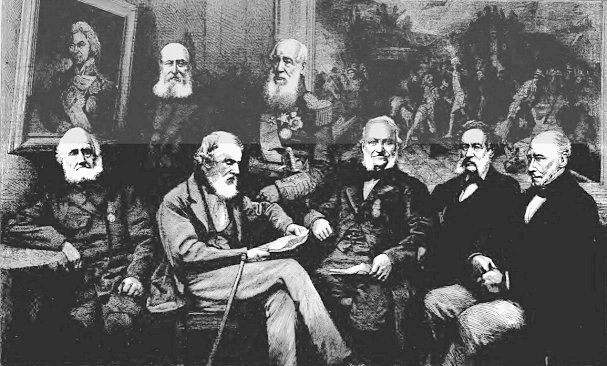
The picture was captioned, The Surviving Officers of the Battle of Trafalgar. From left to right, the seven were: Admiral Spencer Smyth (died April 1879), Commander William Vickery (died at Portsmouth, March 1882), Admiral WW Percival Johnson (died December 1880), Admiral Sir G Rose Sartorius (died April 1885), Admiral Francis Harris (died July 1883), Lieut-Colonel James Fynmore (died April 1887) and Admiral Robert Patton (died September 1883). Clearly these notables were on their last legs when this image was recorded.
Three of the group are wearing their 'Trafalgar Medals'. This description is in inverted commas because no government medal was issued immediately after the battle. It was only in 1848 that a Naval General Service Medal was minted to which ribbon a clasp was attached with the name of the battle (eg Trafalgar) in which the recipient had been involved. Thus, more than one clasp might be attached - the highest number awarded was seven! The medal depicted Queen Victoria and the ribbon was white with royal blue edging. Medal claimants had until 1 May 1851 to stake their claim. Because of illiteracy and limited publicity or simply because they predeceased the inauguration of the award, many did not claim their medal. There is a list of recipients at Genuki's 'Men of Trafalgar Medal Rolls' which notes only 1636 Trafalgar clasps being issued. One is to John Patford or John Radford (sic), a boy on Defence, who is clearly James Pafford.
In 2010, on BBC's Antique Roadshow, the greatx3 grandson of Spencer Smyth took along his ancestor's medal and the picture above.
Numerous newspapers reported the passing of the seven veteran officers (most of whom were now admirals): Sartorius (45 reports found - he was Admiral of the Fleet after all), Johnson (25), Harris (18), Patten (17 - he died at Fareham), Fynmore (12), Smyth (9) and Vickery (4).
It may be surprising therefore that the death of a mere seaman, James Mills, was reported in no fewer than twenty-two newspapers - those based at Bristol, Dundee, Angus, Preston, Northampton, Alnwick, Edinburgh, Guernsey, Sheffield, Coventry, Durham, Huddersfield, Darlington, Birmingham, Hull and St Peter Port as well as Reynolds Paper London, The Illustrated Police News, Pall Mall Gazette, Hampshire Telegraph, Portsmouth Evening News, Hampshire Advertiser. The reason for this high-saturation news coverage must be because of the 'local angle' - James being born at and living at Portsmouth at his death and because of the extra details about him attending the festivities on board Victory on Trafalgar Day and his work.
Thus, James' death created a small ripple in the ocean of naval history. He was probably the penultimate Trafalgar sailor to die at Portsmouth (Vickery being the last) and possibly the last Trafalgar veteran born in the city to pass away.
Philip Wray
(Greatx3 grandson of James Pafford/Mills)
p.wray@hotmail.co.uk